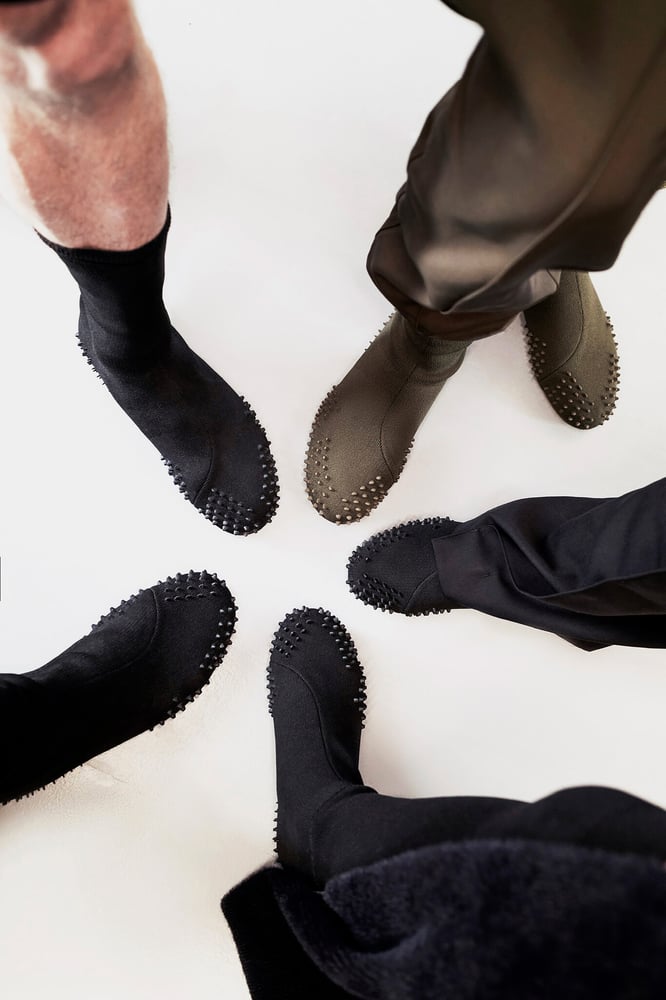Published
November 26, 2025
It has been eleven years since Louis-Gabriel Nouchi first gained recognition for his creative universe. He received a Galeries Lafayette grant at the Hyères International Festival of Fashion and Photography in 2014. The prize led to his first capsule collaboration with the retailer. Today, the designer remains at the helm of his brand, which is front and centre in the designers’ area at Galeries Lafayette Homme on Boulevard Haussmann.
 Louis-Gabriel Nouchi with Caroline Goiffon, managing director of the jewellery brand Statement Paris – Benjamin Boccas
Louis-Gabriel Nouchi with Caroline Goiffon, managing director of the jewellery brand Statement Paris – Benjamin Boccas
Nouchi’s career as an independent player enables him to uphold his convictions, but demands considerable adaptability. He set this out to an audience of professionals at the Welcome on Board event, dedicated to the export of French brands and organised by the sector’s professional federations and economic development committees, held in Paris on November 20.
Sharing the stage with Caroline Goiffon, managing director of the jewellery brand Statement Paris, the two professionals in their thirties discussed their experiences and approaches to running independent brands. Given the focus on export, the American market—often pivotal in the premium and luxury segments, yet increasingly difficult to access in recent months—is unavoidable for smaller labels. For jewellery, the United States sets the tone for global consumption, so Statement Paris must find a way to navigate evolving customs duties. By contrast, for the creative fashion label, the French designer has had to make some drastic decisions.
“With LGN, the United States has historically been my first market,” explained the designer. “But I had to pivot both digitally and in our own retail, and refocus on the European market. I only had stockists in England; I was able to rework that market directly. This is important because it’s the gateway to the English-speaking market. I had to halt all projects in the United States, because we’re in a period of growth. I have to budget for production a year in advance, and the uncertainty is too great right now. I can’t take that risk. On the other hand, affluent clients are coming to Europe. These shifts are significant. And I’m now looking towards the Middle East.”
The designer, who each season draws inspiration from a literary work to create his collections, distils his convictions into inclusive silhouettes. He notably designed the outfits for the Paris Paralympic Games ceremony. His offer has expanded with a versatile approach that allows him to reach different customer profiles, ranging from underwear to more elaborate tailoring.
This diversity is something Nouchi likes to showcase through physical spaces, with a clear vision of his approach.
“I think it’s very complicated to launch a pop-up,” he said.
“We are positioned in the upper-premium segment. The pop-up provides a complete picture of our universe, as in our own boutique in the 11th arrondissement of Paris and on our website. But representing the brand’s universe requires tight control of stock and solid resources for display and logistics. We’ve done it at La Rinascente, at Galeries Lafayette, and at Voo Store in Berlin. In general, we do two pop-ups per season in territories where the brand is already selling well,” he explained.
“It’s demanding because it means covering the wage bill, having dedicated stock, and being able to handle that stock. And then you have to think about your presentation. We opt for modular structures that can be reused in other pop-ups or in our showrooms.”
A pop-up approach, or working with department stores, enables the brand to reach a style-savvy clientele with significant purchasing power. Moreover, recent shifts in consumer behaviour offer new prospects for the brand, according to its founder.
“Now, I notice that the most expensive, high-value pieces perform well in department stores. Discerning consumers are seeking an experience and want to touch fine materials. We steer our entry-level pieces more towards online, and our higher-end pieces towards retail,” he continued.
 LGN’s collaboration with Puma – LGN
LGN’s collaboration with Puma – LGN
This strategy also echoes Nouchi’s collaborative approach. He notes that the collaboration with Puma draws in consumers from around the world who are not necessarily close to his Queer universe, and introduces them to his brand.
“The risk with a collaboration is always the dilution of brand values or miscommunication, because many additional stakeholders come into play when launching a product,” he warned.
“With Puma, the requirement was to create a model with values aligned to LGN. That meant implementing recyclable packaging, and they also reviewed their sourcing to ensure factories used at least 50% bio-based PU across all models. What’s interesting is to have a mass-market product, to reach new audiences while respecting our values, with trainers under €200. And that, I believe, is a tour de force.”
This article is an automatic translation.
Copyright © 2025 FashionNetwork.com All rights reserved.
